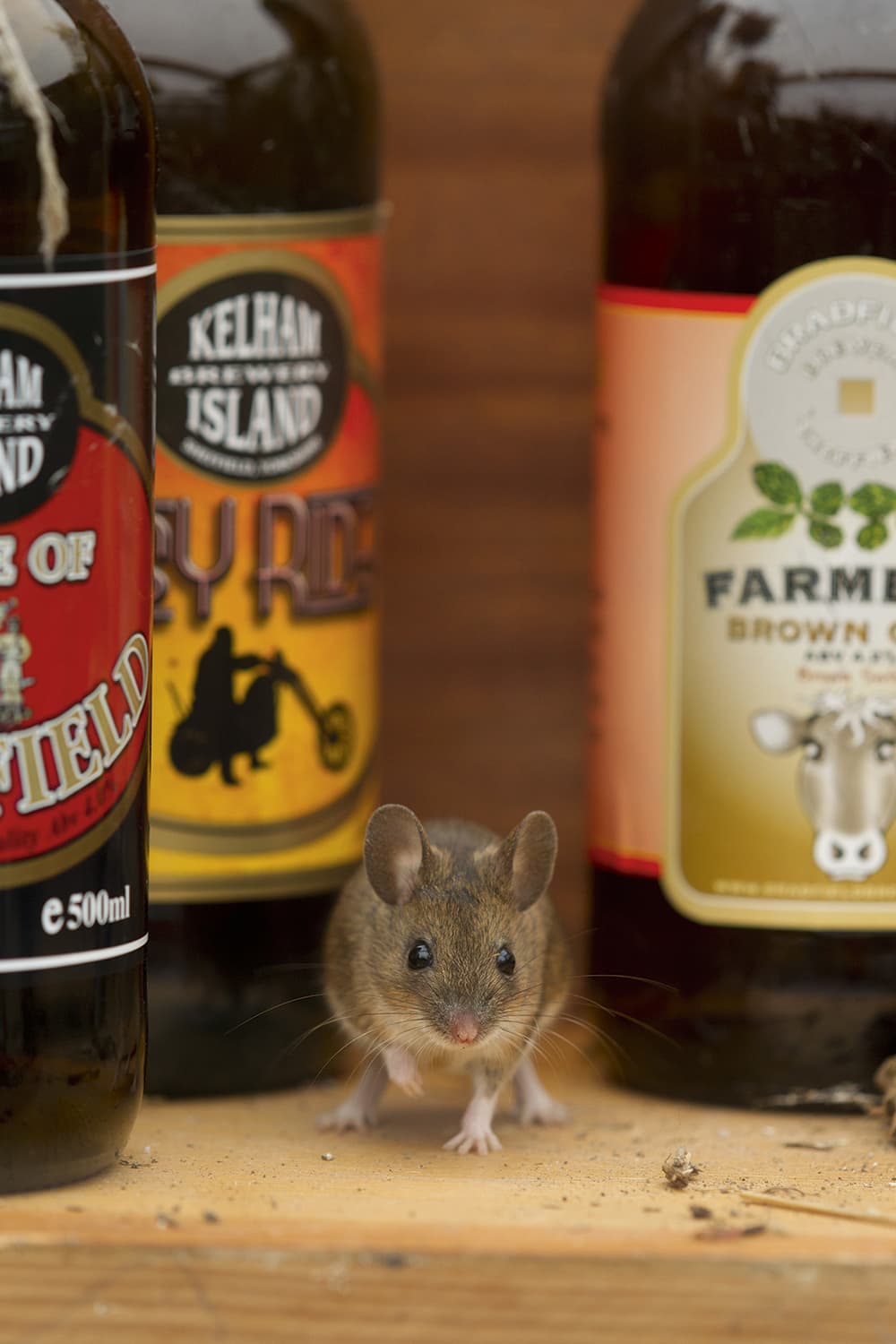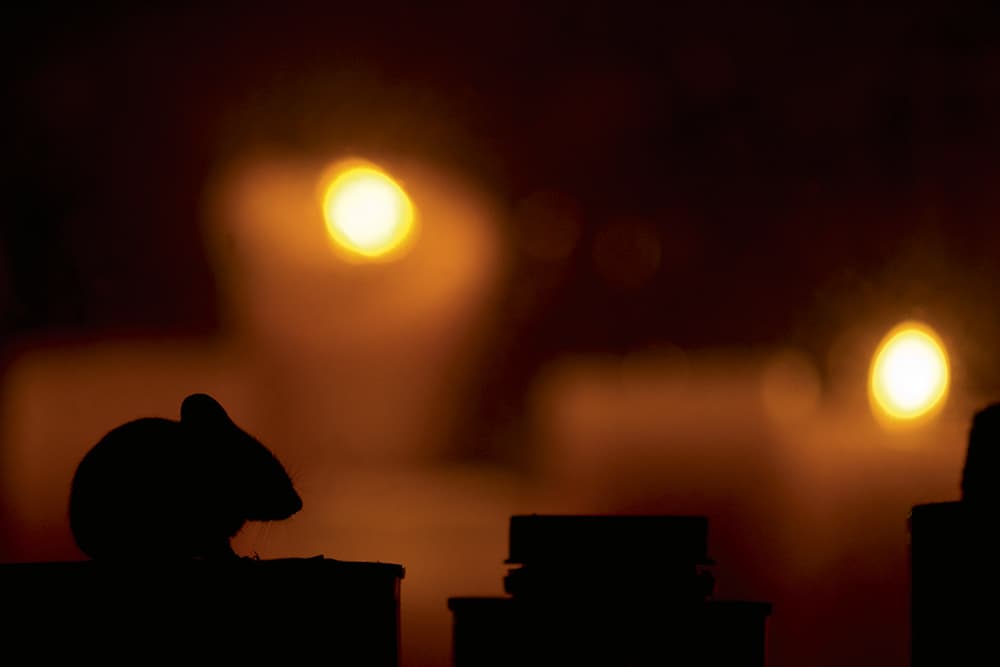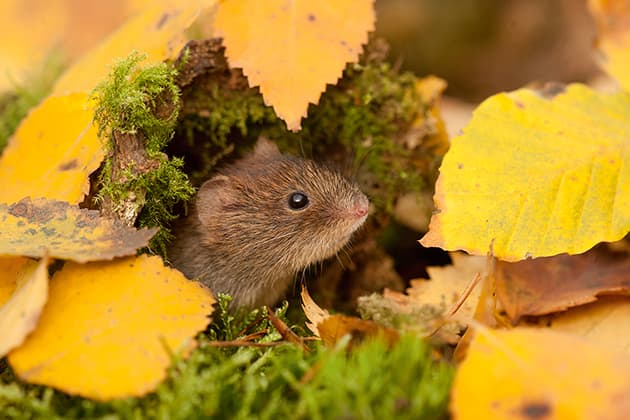About wood mice and bank voles
- Location Wood mice are widespread throughout Britain. Bank voles are widespread, but absent from most of the Channel Islands, the Isles of Scilly, the Scottish islands, Northern Ireland and the Isle of Man.
- Size Adult wood mice measure around 11cm, plus tail. Adult bank voles measure around 10cm, plus tail.
- Diet Wood mice and bank voles eat seeds, fruit and nuts.
- Population The conservation status of both these mammals is classed as ‘common’, but if their numbers fall other species in the food chain, such as owls, kestrels, foxes and weasels, could suffer.
Sit quietly in any wood at night and you’ll start to pick up a bewildering array of noises. Every now and then you will hear the pattering of tiny feet. These are the nimble footsteps of wood mice and bank voles.
Wood mice occur throughout a variety of woodlands and gardens, even into urban areas. Most mice that invade your homes in winter are wood mice and not house mice. They are large (as mice go) with prominent eyes, big ears, brownish fur and long back legs and tail. They could be described as ‘mini kangaroos’ and they can jump and climb really well.
Bank voles are browner with small ears and eyes and shorter tails. Both species are dominantly vegetarians, and eat seeds, fruit and nuts. They breed throughout summer with litters of four to seven youngsters. By autumn, their population is at its annual peak.
Habitat
Wood mice will be living close to you. They may be in your garden, they will almost certainly be in your local woods, and if you’re lucky (a debatable point) they may even live in your house. They are generally nocturnal but will venture out in daylight if temptation is strong enough, that is, if you feed them. They are finely tuned to their world because they have many predators such as owls, kestrels, foxes, weasels and, of course, cats.
These fast moving, svelte mammals are very intelligent and able to exploit new opportunities well. They respond to new foods quickly and if there is an abundant supply, they will collect and cache the food.

This wood mouse was collecting food scraps on a shelf in the shed. Canon EOS-1D Mark IV, 180mm, 1/160sec at f/4.5, ISO 800.
Shooting advice
Location
Years ago, many photographers caught wood mice and kept them in large aquariums, photographing them at night using flash. Today, this approach has fallen out of favour, since there are other ways to get decent shots of these creatures.
First, consider where you want to photograph. In the past I have used the area beneath one of my bird feeders in a wood or a hedge as I noticed that mice and voles visited all day to collect spilt seed.
Select a photogenic spot that will allow the mice to approach under good cover. Sprinkle some seeds along the edge of the cover every day for a week or two. On the day of the photo session prepare the area so you can lie on a mat and use a beanbag on which to rest your camera and lens. I would choose a large lens, say, a 300mm, that focuses close, or add an extension tube.
Be patient
Look through the viewfinder and remove any vegetation that obscures your view of the site. Hide any seed so that it won’t show, and if your camera has a silent mode, use it – then wait. When a mouse or vole appears, lock on using autofocus and take a shot. Don’t worry if the animal runs off – with patience it will gain confidence and allow you to switch to continuous firing, perhaps on your second or third session.
Add variety
Be creative – use hollow logs, old teapots or beer bottles to add variety to your images. Many of my shots feature mice that lived on the bird seed in my garden shed, proving you don’t have to go far to find photo opportunities.

Select a photogenic spot, scatter some food and then be patient. Canon EOS-1D Mark IV, 180mm, 1/200sec at f/3.5, ISO 1250.
Kit list
Beanbag
A beanbag lets you get down low and supports your gear while keeping your face off the ground! Wildlife Watching Supplies has an impressive range.
Telephoto lens
A telephoto lens is ideal for creating frame-filling shots of small animals, and the Canon 70-300mm f/4-5.6 IS II USM is a fine example. This lens has an incredibly quiet motor, which is great for shooting wildlife.
About Paul Hobson
After more than 20 years working as an environmental-science lecturer, Paul took up wildlife photography full time. He enjoys travelling, but prefers working in the UK – he finds the demands on the photographer to be harder, but the rewards greater. www.paulhobson.co.uk.







